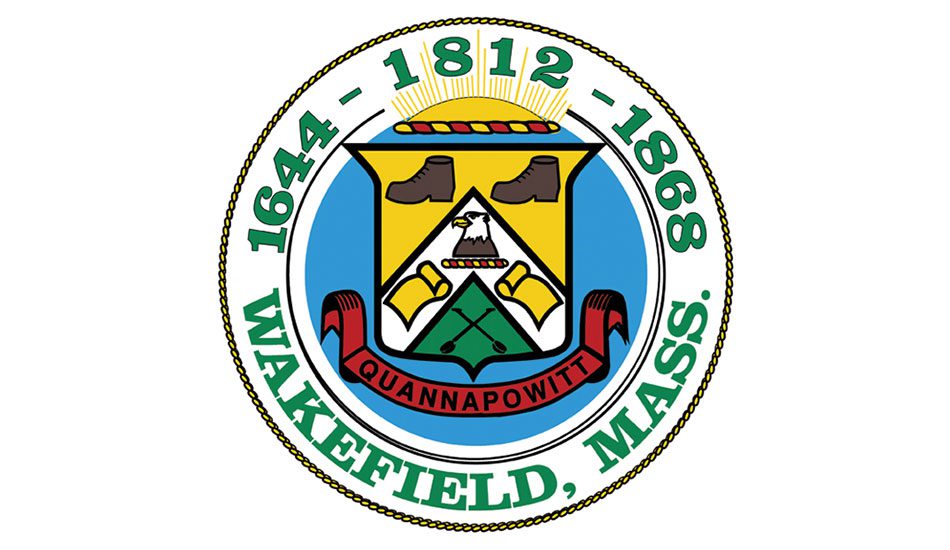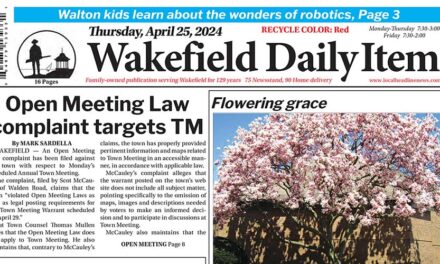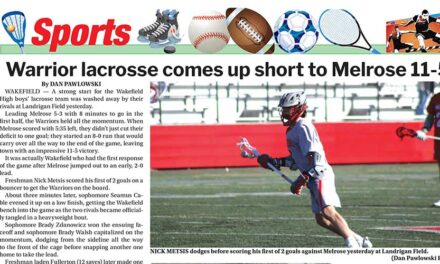By MARK SARDELLA
WAKEFIELD — In what has become an annual ritual, the Town Council last night voted for the maximum shift of the property tax burden away from homeowners and onto the commercial tax base. Notwithstanding that action, the average homeowner in Wakefield will see his property tax bill rise by about 5.4 percent, or about $422 for the year.
Director of Assessments Victor Santaniello appeared before the Town Council as part of last night’s annual tax classification public hearing.
Santaniello noted that selecting a Residential Factor of “1” would yield a single tax rate of $12.84 per thousand of value for all residential and commercial properties. However, state law allows the town to select a factor less than 1 thereby shifting more of the tax burden onto the commercial/industrial classes of properties. Historically, he reminded the board, Wakefield has chosen the maximum allowable shift factor to afford residential taxpayers the lowest share of the tax burden allowed by state law.
At that maximum shift, the average single-family home, valued at $701,100 (up 10.7 percent from last year) would be taxed at a rate of $11.73 per $1,000 of valuation or about $8,224 for the year. That is $422 (5.4 percent) more than last year.
The maximum shift also means that the average commercial/industrial property valued at $1,464,000 (up 2.2 percent) would be taxed at a rate of $22.46 per $1,000 of valuation (down 5.5 percent from last year) and pay $32,881 for the year, which is $1,173 (3.4 percent) less than last year.
Santaniello noted that FY 2023 is the ninth year of the full debt exclusion for the Galvin Middle School. The Debt Exclusion adds $2,484,491 to the town’s FY 2023 total tax levy. It adds $0.34 to the residential tax rate or $238 to the average single family home tax bill for the year and $0.64 to the CIP Rate, or $935, to the average commercial tax bill.
Santaniello talked about the town’s senior citizen property tax discount program. He said that during the third year of offering this exemption there were 226 applications received of which 215 were approved. The average amount granted was $1,027. The maximum was $1,170 and the minimum was $35.
The small number of application denials included those with excessive assets, co-applicant age and/or real estate trust interest issues. Those who received the maximum amount of $1,170 will see an approximate 14.25 percent reduction in real estate taxes based on the average single-family home value.
The total amount of senior tax exemptions granted was $229,256. This exemption added $0.04 to the residential tax rate which translates into an increase of $28.04 on the average single family tax bill to help local seniors continue to remain independent and age in place.
Santaniello thanked Council on Aging Director Karen Burke and the rest of the Council on Aging staff who promoted this local senior exemption and helped to get the word out to the senior population.
No one from the public offered any feedback at last night’s tax classification hearing.
The Town Council voted 6-1 to approve Santaniello’s recommendation under tax classification. Councilor Edward Dombroski was the lone “No” vote.
Dombroski maintained that a residential tax increase of 5.4 percent was too much in the current economy with inflation at 7.7 percent and families facing soaring heating costs this winter.
“We have to be able to find a way to make this work without going up 5.4 percent,” he said. “It’s too high an increase especially during these precarious economic times. I can’t support going 5.4 percent on the residential tax.”
Dombroski said that when the board sets the tax levy, going up the full 2½ percent allowed by law should not be assumed or automatic.
Councilor Jonathan Chines disagreed.
“We are all cognizant of the burden families face,” he said. “We are trying to fund the budget that Town Meeting approved.” He argued that voting to lower the tax rate does not necessarily help those families that are struggling, because most of the dollars saved would go to higher income individuals with higher income properties.
“That’s certainly not what I’m interested in doing,” Chines said.
The Town Council also took three other related actions last night.
They declined to offer an “Open Space Discount.” A maximum open space exemption of 25 percent may be adopted, Santaniello explained. However, the Town has never voted a discount for open space since no properties have been identified which fulfill the requirements under law.
They also declined to offer a residential exemption up to 35 percent of average residential value. Santaniello explained that this exemption has only been adopted in a handful of communities including Boston, Cambridge, Chelsea and Brookline, where more housing is investor-owned. Most homes in Wakefield are owner occupied. Offering this exemption would mean that the residential tax rate would rise substantially before any discount was applied and approximately 30 percent of homes would shoulder the burden.
The Town Council voted not to offer a small commercial exemption of up to 10 percent of valuation for certain commercial properties. Eligible business cannot have more than 10 employees as certified by the Department of Employment & Training and the building Value cannot exceed $1,000,000. One business in a building could not qualify unless every business qualified. The exemption goes to the building owner. Santaniello said that the Assessing Department is unaware of any business in town meeting these requirements.





